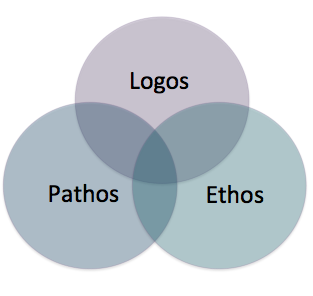Learn It
Being able to evaluate an author’s use of reasoning and evidence is one of the most important skills of an informed citizen. An author’s claim can be presented in a variety of formats, including a speech, video, campaign advertisement, blog post, newspaper editorial or article.
When presenting a claim, an author will use different types of evidence to persuade you to believe that the claim is valid or correct. There are three techniques used by authors to convince the reader to support their position or point of view: Pathos, ethos and logos. When evaluating the validity of an author’s claims, you are looking for relevance and quality of the evidence, and acknowledgement of opposing claims with evidence and reasoning that refute those claims.

Logos, pathos and ethos are three techniques authors use to support a claim.
How Authors Support Their Claims
Review the information and videos below to learn how authors use three different techniques to support their claims.
Let’s examine each technique closely.
Ethos
The first technique is ethos, which is an appeal to the reader that they should agree with the author because of the author's character or credibility. The author may reference an occupation, reputation, past actions or expertise. This type of support is illogical, or a logical fallacy. It is not a valid form of evidence to support a claim.
Let’s review an example of ethos used by President Bush in a 2005 State of the Union address.
Pathos
The second technique is pathos, in which the author makes emotional appeals to the reader or audience. This type of support is a logical fallacy and is not a valid form of evidence to support a claim.
Let's review an example of pathos used by President Obama in a 2012 State of the Union address.
Both ethos and pathos are very effective and persuasive techniques, but a critical reader is able to identify the logical fallacies and recognize them as weak supports for an author's claim.
Logos
The third technique is logos, or an appeal to logic or reason. On the White House website, an infographic illustrates some factual data about women in the workforce.
Review the three charts on the Women in Workforce infographicopens in new window.
By showing this factual data, the author appeals to the viewer’s sense of logic to support a minimum wage increase.








